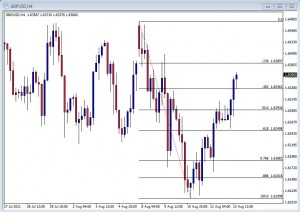Want FULL ACCESS To
ROSS’ DAILY TRADE ROOM?
Simply Click The Get Started Button Right Now!
In this post I don’t want to spend a lot of time on how the Fibonacci ratios are derived. With a little internet research you can find a multitude of websites that can give you that information. Instead I want to focus on basic application of the common levels that Forex trader’s use.
There are 3 basic steps to applying the Fibonacci retracement levels to the charts. So this article will discuss the what, where and how to applying these levels.
First, for the purpose of technical trading, the Fib levels that we will focus on are the 0.236, 0.382, .50, 0.618, 0.786 and the 0.886. Also, there are a few Fibonacci extensions that will come in handy. Those are the 1.27, 1.382 and 1.618. With the exception of the .50, all of these levels can be derived from the Golden Ratios found within the Fibonacci sequence or the converse of one of the ratios. The .50 is not a Fib ratio but a common retracement level widely recognized by traders as a half way point of retracement.
Next, let me define what a retracement level is: a retracement level is the point in which you expect the market to draw back against the trend, stop, and return back in the direction of the trend. This of course would require a definition of the trend. The trend is the general direction the market is moving viewed in short, medium and long term outlooks. All that said, the trend and subsequently the retracement levels will require some subjectivity and artistry in their interpretation by the trader. But I would suggest that the wider view point that you take of the trend the closer to the “general direction” you will be viewing. For example look at the image on Fig. 1, here we can see an uptrend on the 1 hour chart. However, looking at Fig. 2 you might interpret the 1 hour trend simply as a retracement of the 4 hour trend. So where do you apply the Fib levels?
Again, taking an overall view of the general direction, it would be advisable to apply the retracement levels on the wider view, in this case the 4 hour chart as in Fig. 3. This would begin to tell us where the potential reversal points would be for the current upswing viewed on the 1 hour chart that could send the market back down in the direction of the previous 4 hour trend.
So, now that we have a little understanding of what the levels are and where to apply them, let’s look at how to draw them on the chart. The good news is that most charting software will do the math for us and all we have to do is apply it. For the application of the levels, it might help to view the ratios as percentages. For instance we can view the .382 as 38%, the .618 as 62% or the 1.27 as 127%. Viewing the ratios in percentages helps to interpret the trend correctly. The beginning of the trend is 0% and the end of the trend is 100%. The “end of the trend” is the closest to the current market price or right side of the chart. Mathematically then, this would assume that the Fib extensions would then be beyond the 100% level of the trend. That being said then, you would draw the Fib levels in a manner that places the retracement levels in their mathematically correct positions. On many charts that means you start at the end of the trend and draw back to the beginning of the trend as seen in Fig. 4.
As you can see, this places the Fib extensions at the bottom of the chart as extensions beyond the 100% level of the 4 hour trend. We can now use these extensions as profit targets when and if the market falls back down, beyond the last 4 hour low as a continuation of the 4 hour downtrend.
Of course this is just one interpretation of the trend on the 4 hour chart. There are many vantage points to consider. Using these same theories on a 30 minute compression or a daily compression on the same currency pair you are going to find conflicting trends and potential profit targets. Hence the artistry and subjectivity comment earlier.
So what about the where and how? This is going to take some experimentation and study to work this into your own trading plan. But what I can say is this, Fibonacci helps us visually recognize naturally occurring patterns in the market, when you begin to draw Fibs on multiple compressions and trends, you might find price levels where the Fibs from these different perspectives overlap. These overlaps are helping to identify naturally occurring market patterns that you can use as you look for higher probability outcomes to your trading. Will the market stop and reverse at the levels every time? No, but the more that you study these Fib levels I think that you will come to see their value. Using Fibonacci retracement levels and extensions, along with other confirming indicators, can help increase your chances of making profitable trade decisions.








